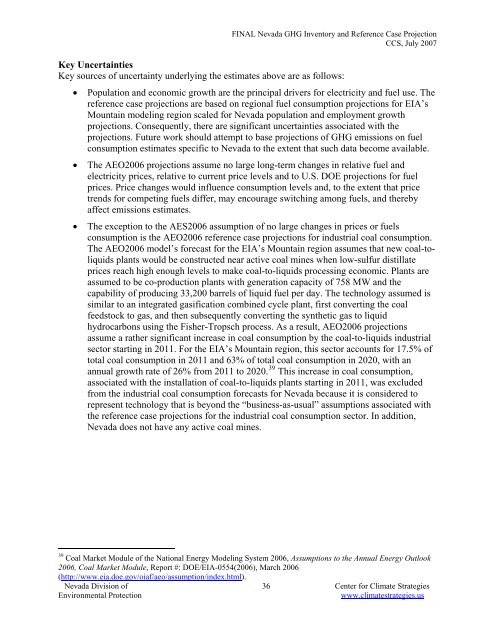Nevada Greenhouse Gas Inventory and Reference Case Projections
Nevada Greenhouse Gas Inventory and Reference Case Projections
Nevada Greenhouse Gas Inventory and Reference Case Projections
You also want an ePaper? Increase the reach of your titles
YUMPU automatically turns print PDFs into web optimized ePapers that Google loves.
FINAL <strong>Nevada</strong> GHG <strong>Inventory</strong> <strong>and</strong> <strong>Reference</strong> <strong>Case</strong> Projection<br />
CCS, July 2007<br />
Key Uncertainties<br />
Key sources of uncertainty underlying the estimates above are as follows:<br />
• Population <strong>and</strong> economic growth are the principal drivers for electricity <strong>and</strong> fuel use. The<br />
reference case projections are based on regional fuel consumption projections for EIA’s<br />
Mountain modeling region scaled for <strong>Nevada</strong> population <strong>and</strong> employment growth<br />
projections. Consequently, there are significant uncertainties associated with the<br />
projections. Future work should attempt to base projections of GHG emissions on fuel<br />
consumption estimates specific to <strong>Nevada</strong> to the extent that such data become available.<br />
• The AEO2006 projections assume no large long-term changes in relative fuel <strong>and</strong><br />
electricity prices, relative to current price levels <strong>and</strong> to U.S. DOE projections for fuel<br />
prices. Price changes would influence consumption levels <strong>and</strong>, to the extent that price<br />
trends for competing fuels differ, may encourage switching among fuels, <strong>and</strong> thereby<br />
affect emissions estimates.<br />
• The exception to the AES2006 assumption of no large changes in prices or fuels<br />
consumption is the AEO2006 reference case projections for industrial coal consumption.<br />
The AEO2006 model’s forecast for the EIA’s Mountain region assumes that new coal-toliquids<br />
plants would be constructed near active coal mines when low-sulfur distillate<br />
prices reach high enough levels to make coal-to-liquids processing economic. Plants are<br />
assumed to be co-production plants with generation capacity of 758 MW <strong>and</strong> the<br />
capability of producing 33,200 barrels of liquid fuel per day. The technology assumed is<br />
similar to an integrated gasification combined cycle plant, first converting the coal<br />
feedstock to gas, <strong>and</strong> then subsequently converting the synthetic gas to liquid<br />
hydrocarbons using the Fisher-Tropsch process. As a result, AEO2006 projections<br />
assume a rather significant increase in coal consumption by the coal-to-liquids industrial<br />
sector starting in 2011. For the EIA’s Mountain region, this sector accounts for 17.5% of<br />
total coal consumption in 2011 <strong>and</strong> 63% of total coal consumption in 2020, with an<br />
annual growth rate of 26% from 2011 to 2020. 39 This increase in coal consumption,<br />
associated with the installation of coal-to-liquids plants starting in 2011, was excluded<br />
from the industrial coal consumption forecasts for <strong>Nevada</strong> because it is considered to<br />
represent technology that is beyond the “business-as-usual” assumptions associated with<br />
the reference case projections for the industrial coal consumption sector. In addition,<br />
<strong>Nevada</strong> does not have any active coal mines.<br />
39 Coal Market Module of the National Energy Modeling System 2006, Assumptions to the Annual Energy Outlook<br />
2006, Coal Market Module, Report #: DOE/EIA-0554(2006), March 2006<br />
(http://www.eia.doe.gov/oiaf/aeo/assumption/index.html).<br />
<strong>Nevada</strong> Division of 36 Center for Climate Strategies<br />
Environmental Protection<br />
www.climatestrategies.us
















